#INDIANA JONES AND THE LAST CRUSADE THE GRAPHIC ADVENTURE
Explore tagged Tumblr posts
Photo

USA 1990
#USA1990#LUCASARTS#ADVENTURE#LICENSED#INDIANA JONES#IBM#MACINTOSH#AMIGA#ATARIst#FM TOWNS#CDTV#INDIANA JONES AND THE LAST CRUSADE THE GRAPHIC ADVENTURE
20 notes
·
View notes
Photo


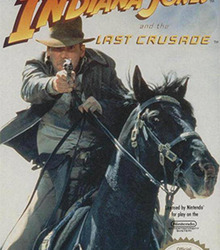
Indiana Jones and the Last Crusade: The Action Game was published in 1989 by Lucasfilm Games, based on the film of the same name. The game was released for the ZX Spectrum, Amstrad CPC, Commodore 64, Atari ST, Amiga, IBM PC, MSX, Master System, NES, Game Boy, Sega Genesis and Game Gear.
It is a different game from Indiana Jones and the Last Crusade: The Graphic Adventure, also released in 1989. There is also a different game for the Nintendo Entertainment System titled Indiana Jones and the Last Crusade, released by Taito in 1991.
-- https://en.wikipedia.org/wiki/Indiana_Jones_and_the_Last_Crusade:_The_Action_Game
#indiana jones#and the last crusade#game#games#video game#video games#lucasfilm#nes#graphic adventure#action game#lucasfilm games
0 notes
Text

Indiana Jones and the Kingdom of the Crystal Skull (2008, Steven Spielberg)
18/03/2024
Indiana Jones and the Kingdom of the Crystal Skull is a 2008 film directed by Steven Spielberg, starring Harrison Ford and based on the story conceived by executive producer George Lucas.
Set in 1957, the fourth film in the film series sees an elderly Indiana Jones facing agents of the Soviet Union led by Irina Spalko in search of a crystal skull. "Indy" is helped by his great love Marion Ravenwood, the greaser "Mutt" Williams and his adventure companion Mac. John Hurt and Jim Broadbent play two academics.
The film, the fourth chapter of the adventures of the famous archaeologist (even if chronologically it is the 26th, counting television productions in addition to the films), was already in the production phase at the time of the distribution of Indiana Jones and the Last Crusade (1989), but the realization was postponed because Spielberg and Ford disapproved of Lucas' initial idea.
The production team stated that the film was shot, like the three previous ones, favoring the use the stuntmen rather than the use of computer graphics and special effects. Jeb Stuart, Jeffrey Boam, Frank Darabont and Jeff Nathanson wrote several drafts of the screenplay; in the end it was David Koepp who produced a script that managed to satisfy Spielberg, Lucas and Ford at the same time. Filming finally began on June 18, 2007 and took place in New Mexico, New Haven (Connecticut), Hawaii, Fresno (California) and Los Angeles for interiors.
#Indiana Jones and the Kingdom of the Crystal Skull#film#2008#steven spielberg#harrison ford#executive producer#george lucas#1957#Indiana Jones#soviet union#crystal skull#marion ravenwood#greaser#List of Indiana Jones characters#John Hurt#jim broadbent#archaeology#indiana jones and the last crusade#1989#Stunt performer#computer graphics#jeb stuart#jeffrey boam#frank darabont#Jeff Nathanson#screenplay#david koepp#2007#new mexico#New Haven Connecticut
2 notes
·
View notes
Text

"Blaise Owens and the War Conspiracy" (Bowler Hat Interactive, July 1989) Unfortunately this game never gained much popularity due to being released at the same time as "Indiana Jones and the Last Crusade: The Graphic Adventure" by Lucasfilm Games (later known as LucasArts), which had better graphics and was based on an already popular franchise. Today the video game is mostly forgotten and considered lost media due to its low sales and the copies that were not sold being destroyed, there aren't many hints that the game ever existed. Only a few screenshots like this one exist somewhere on the internet.
(A mockup I made, based on the old LucasArts Point and Click games from the 80/90s)
#Art#Pixel Art#Bowler draws#art#Blaise Owens#Owens family#unreality#mockup#Video game#Point & Click game#Point n Click game#Computer game#Video games#Bowler Hat Interactive
6 notes
·
View notes
Text

Indiana Jones and the Last Crusade: The Graphic Adventure è un'avventura grafica basata sul film Indiana Jones e l'ultima crociata, da cui riprende la trama. Venne realizzato nel 1989 dalla LucasArts, sotto la direzione di Noah Falstein, in collaborazione con David Fox e Ron Gilbert.
#Indiana Jones#Indiana Jones and the last crusade#Indiana Jones e l'ultima crociata#lucasfilm#Steven Spielberg#Harrison Ford#Sean Connery#Graphic adventure#Indiana Jones video games#Lucarts
1 note
·
View note
Text

In a recent copy of Retro Gamer they had a feature on Indiana Jones and the Last Crusade: The Graphic Adventure.
It was an early(ish) LucasFilm game (before they were known as LucasArts) created by some big names such as Ron Gilbert (Monkey Island), Noah Falstein (Fate of Atlantic) and Steve Purcell (Sam & Max)
The original release used 16 colour EGA graphics, which places it firmly in the 286/386 era of PC gaming. Although a later rerelease refreshed it with full 256 colour VGA visuals.
By the time my friends were swapping copies of LucasArt games is was during the golden era of point and click adventure games. Such as The Fate of Atlantis, Monkey Island and Day of the Tentacle.


When I did later hear about the Last Crusade I dismissed it as LucasArts before their prime and didn't think it was worth investing the time to play and explore it. That was until I read the Retro Gamer article which really opened my eyes to the effort and love poured into the creation of the game.
With that renewed interest and eagerness to play it I decided it would be era appropriate to play it on my trusty ICL 386 machine, complete with mechanical keyboard and VGA CRT monitor.
I decided to do it by the book and purchase a legitimate copy from GOG. It was at this point I found myself running into the problem Wouter from Brain Baking discovered, which is that GOG doesn't really stand for Good Old Games anymore.

Upon opening my legitimate download I discover GOG had packaged it up to run through ScummVM. Certainly a good choice to make the game reliably run on modern machines, but of no use for those of us who need an original executable to play it on original hardware.
So with regret I had to resort to searching the abandonware sites looking for an EGA or VGA PC version, which was a little harder than I expected.
Thankfully I did manage to track down a version (which hopefully didn't contain a virus) and load it up onto my 386, ready for a Christmas 2022 playthrough. Quite appropriate given Indy's return to the cinema in early 2023.




2 notes
·
View notes
Photo







Video Game Artist Spotlight: Steve Purcell
Steve Purcell is an American cartoonist, animator, voice actor, and game designer. He is mostly known for creating the Sam & Max series of comics which would later spin-off into video games. In his early days, Purcell would create comics while attending California College of Arts in 1980. After graduation he would work freelance for Marvel Comics. He would later join LucasArts during its “golden age” as an animator/artist in 1988. There he would create the cover art for ZaK McKracken and Secret of Monkey Island 2 and would create Sam & Max comic strips for an internal magazine within LucasArts called The Adventurer. This positive reception would lead to the critically acclaimed Sam & Max Hit the Road in which Purcell was heavily involved with. After LucasArts, Purcell would work at Pixar in which he would work on films like Cars, Ratatouille, and Brave in which he co-directed with Brenda Chapman and Mark Andrews.
His blog.
Titles Worked On:
Zak McKracken and the Alien Mindbenders (1988) – Artwork
Pipe Dream (1989) – Artwork
Indiana Jones and the Last Crusade: The Graphic Adventure (1989) – Animation, Artwork and whip research
Maniac Mansion (1987) – Artwork
The Secret of Monkey Island (1990) – Graphics and artwork
Monkey Island 2: LeChuck's Revenge (1991) – Animation, graphics and artwork
ToeJam & Earl (1991) – Original concept art/Character designs
Zombies Ate My Neighbors (1993) – Artwork
Sam & Max Hit the Road (1993) – Design, graphics and artwork
Herc's Adventures (1997) – Artwork
The Curse of Monkey Island (1997) – Artwork
Tales of Monkey Island (2009) – Artwork
Sam & Max: The Devil's Playhouse (2010) – Artwork
#sam & max#sam and max#steve purcell#Pixar#art#artist#artist spotlight#video games#lucasarts#90s#secret of monkey island
88 notes
·
View notes
Text
Lost Horizon (the adventure game)

The 2010 adventure game Lost Horizon is an excellent example of why a piece of media doesn’t have to be original to be good.
Even the title as you might notice is not original (which is kinda annoying if you want to look up information on this game). The game is not an adaptation of James Hilton’s classic novel, even if the game’s central idea of a Shambhala hidden away in the Tibetean mountains is clearly inspired by the book’s Shangri-La.
The game is set in 1936 and stars Fenton Paddock, a pilot and ex-army British army man who has to find the key to Shambhala in the hope of finding his friend Richard who has disappeared. But he has to get ahead of the Nazis who wants to find Shambhala to use its power to take over the world.
It is a very stock adventure plot as you can tell. The heavy inspiration from Indiana Jones is evident, especially the fighting the nazis part (which is something that never happened in real 1930s adventure film serials, due to Hollywood’s desire to sell films to Nazi Germany). And there are clearly borrowings from the IJ films. The game’s opening with the hero and heroine escaping from gangsters in Hong Kong in a Ford Trimotor is clearly inspired by the opening of Temple of Doom (which is set in Shanghai of course, but the similarities are still there). There are two sequences in a row where Fenton must go both to to Berlin and a Nazi castle in his quest, which is probably inspired by Last Crusade (the game’s castle sequence actually features a castle used by Himmler in real life, Wevelsburg, and you get to explore the infamous room in the North Tower with the black sun symbol, which is quite fun.)
The gameplay is also very traditional point-and-click adventure game, with very few changes from the 1990s formula. The only real addition to the 90s formula is the addition of holding down spacebar to see all interactable elements on the screen, and that feature seems to already have become standard in the adventure game genre by the late 00s. The gameplay style being emulated is thankfully Lucasarts and not Sierra, since there is no dying in this game. And in both story and gameplay, Lost Horizon feels like a spiritual successor to Lucasart’s Indiana Jones and The Fate of Atlantis. And it feels closer to that game than its actual sequel, which was heavily Tomb Raider inspired.
So this game is 100% derivative, yet it is done so well. The developers imitate but they clearly understand what they imitate.
To begin with: this game looks gorgeous. And it does so with fairly simple graphics by going for a comic-book style aesthetic. There are 3d models of the characters in this game, and they are not that advanced. In fact they are probably this game’s main weakness graphically, which the game compensates for with 1: using simple cartoon character designs that avoid realistic detail and 2: using a lot of hand-drawn 2d art. The backgrounds in-game are all hand-drawn art and they are gorgeous. Also during dialogue instead of relying solely on the primitive 3d models, they instead use 2d portraits of the characters. This artstyle is very appealing and contributes a lot to my enjoyment of this game.
The gameplay is also quite a solid point-and-click adventure. The puzzles feel imaginative without being totally illogical. The game’s main way of adding complexity is the addition of secondary playable characters in certain segments. This second playable character in those segments is the female lead Kim in all but the final one. In those segments you can switch between controlling Fenton and Kim with each character usually having their own area to explore and they need to cooperate to reach their goal.
With its no failure-states design,Lost Horizonis definitely on the easier side. While I have played a lot of adventure games, I wouldn’t say I’m that good at them, I usually will have to use online hints/a walkthrough at some point. And that wasn’t the case at all in this game, I never got stuck for long and never had to use a walkthrough. And that is super-rare in an adventure game. I could figure out all of the puzzles with a little trial-and-error at most.
Still while I appreciate a challenge, I don’t think being too easy is necessarily a failing. It is better for a developer to err on the side of making a game too easy than the opposite. Especially in the adventure genre, where “difficulty” often means making the game’s puzzles too illogical and obtuse instead of more intelligent puzzle design. In the case of Lost Horizon, this lack of difficulty made for a very flowing and ultimately enjoyable gameplay experience.
The story is probably the game’s main weakness. The main love story between Fenton and Kim feels totally underdeveloped, it is supposed to go from good-natured bickering from love and you never really get a strong sense for that change. They never feel as more than friends until that final cutscene. The final cutscene also feels like a total anti-climax in general, even if the gameplay leading up to it is quite fun.
The characters are all fairly lacking in complexity and development, and it is very much a stock adventure story, with really nothing original added.
The writers at least try to update the adventure genre for the 2010s which carries a lot of sexist, racist and colonialist ideological baggage. The object of the quest is revealed to be nothing Fenton neither can or should conquer or take for himself, which somewhat softens any colonial undertones (even if Fenton’s backstory literally is that he used to work as a soldier for the British empire). There are Chinese Triad gangsters as side-villains in the opening of the story, but there is also Kim, the female lead, who is a capable Chinese woman who rescues herself in the climax. Kim is very fun, but she is ultimately the sidekick to the white english male hero Fenton. So this attempt to update the politics of the genre is not entirely successful.
Yet these faults I still enjoyed this story a lot. The writers do understand what makes this type of adventure story work. It has all of the clichés but also has pretty much all you want from an adventure story too. Fenton needs to go a long globetrotting journey to find the key to Shambhala, and so the game features a lot of travelling, more than you might expect from the beginning of the game. And it features practically all the cool environments you want in an adventure story. Hong Kong, Himalayan mountains. Marrakech and its surrounding desert, 30s Berlin, a medieval nazi-controlled castle, an Indian jungle, and of course plenty of ancient temples. This game has it all. It is tremendous fun to explore all these varied locations, all depicted with well-made 2d backgrounds.
Being an adventure game where you can’t even die, the action sequences are naturally a bit limited. The action is mostly cutscenes and playable set-pieces where the character is supposed to be in danger, but you can paradoxically take all the time in the world to solve the puzzle to defeat the enemy. But they are still fun and add to the adventure film tone.
The characters are fairly underdeveloped and remain simple archetypes, but they are well-written enough to give them charm and likeability. Mainly it is because the dialogue has some wit to it, which makes especially our main character Fenton rather charming. And fighting nazis is a frequently used idea in both film and games, but it never gets old.
So that is Lost Horizon. It is a game that does pretty much nothing new but despite some flaws does it rather well. If you are a fan of the adventure genre, as in both the genre of video games and the fiction genre, it is worthy of playing.
3 notes
·
View notes
Photo

Indiana Jones and the Last Crusade: The Graphic Adventure (DOS), 1989.
#abandonware#gaming#video games#retro games#80s#indiana jones#vaporwave#retrowave#aesthetic#pixel art#softgold computerspiele#lucasfilm games
68 notes
·
View notes
Photo

Indiana Jones and The Last Crusade: The Graphic Adventure Año: 1989 Plataformas: Amiga, Atari ST, Mac, PC, FM Towns, Commodore CDTV
2 notes
·
View notes
Photo

USA 1990
#USA1990#COMPUTE!#BOOKS#ADVENTURE#RPG#ACTION#SIMULATION#STRATEGY#IBM#TIMES OF LORE#CURSE OF THE AZURE BONDS#TONGUE OF THE FATMAN#THE COLONEL'S BEQUEST#ARHIPELAGOS#HEAVY BARREL#INDIANA JONES AND THE LAST CRUSADE THE GRAPHIC ADVENTURE#INDIANA JONES AND THE LAST CRUSADE THE ACTION GAME#AIRBORNE RANGER#F19 STEALTH FIGHTER#PIRATES!#RED STORM RISING#GUNSHIP#KEEF THE THIEF#SUPER HANG ON#CHUCK YAEGER'S ADVANCED FLIGHT TRAINER#F16 COMBAT PILOT#ABRAMS BATTLE TANK
10 notes
·
View notes
Link


4 notes
·
View notes
Text
Wineskin winery pc games

Wineskin winery pc games install#
Wineskin winery pc games series#
Wineskin winery pc games download#
Check out the video tutorial below to see the visual instructions and some game-play with the demo version. Before downloading the wrapper, make sure security settings are set correctly when you have Mavericks OSX or higher. Game has great graphics and has realistic gameplay. Rfactor is a popular racing game in the way of Live for Speed and Race07. After installation of the GOG.com game, click “exit” and then in Porting Kit click “Play”! Have fun! Then in Porting Kit search the game on the library –> server tab and click install.Ĥ. Get the Indiana Jones and the Emperor’s Tomb setup file from you GOG.com Library when you don’t own it yet.ģ. Get Porting Kit if you don’t have it yet.Ģ. Improvised weapons such as shovels, chairs and table legs also can be used to fend off adversariesġ. This time, in addition to using his trademark whip and pistol, Indy can engage in fierce hand-to-hand combat against foes, many of whom are well-versed in martial arts. Indy’s latest adventure plays out in dramatic fashion thanks to new gameplay features such as brawling combat. If you like Indiana Jones adventure games, then Indiana Jones and the Fate of Atlantis and The last Crusade may also be something for you. I tested the game both on my Nvidia 640M iMac and my Intel HD 5000 Macbook air and fine. It’ll take more than just a trusty whip and pistol to avoid the perils of the Emperor’s Tomb. This globe-spanning adventure pits you against evil Nazis and the Asian underworld. Go to the Porting Kit game page for more info up here…Īs Indiana Jones, you’ll travel to 1935 China to prevent a powerful artifact from falling into evil hands. Experience improved vehicle handling as you take control of tanks, helicopters, and more. Thrilling combat scenes put you in the middle of the mayhem. The Crysis Warhead storyline features a fresh take on the story of the original Crysis, delivering all of the excitement and energy that you’ve come to expect. Click “Play” to start the game! Have fun! After installation of the game, “exit” the GOG installer.ĥ. Then in Porting Kit search the game on the library –> server tab and click install.Ĥ.
Wineskin winery pc games download#
Then buy/download the GOG.com setup file from Crysis Warhead from GOG into your download folder.ģ. Get Porting Kit if you don’t have it yet.Ģ.
Wineskin winery pc games install#
Simply install it into porting Kit with the simple steps and Enjoy!ġ. The game is quite heavy, so a medium-end and high-end iMac is required to play the game on good settings. A special thing with this one is that the game is 64-bit! Yes that’s right, and this means this also requires the latest Porting Kit version, so make sure you updated to the latest version (fixed some issues with creating 64-bit engines) to be able to install the game without issues.
Wineskin winery pc games series#
On many request! Crysis Warhead for Mac is added to Porting Kit! We already added the first Crysis game and for Crysis 2 to Porting Kit and now to make the series complete here is Crysis Warhead as well.

0 notes
Text
Real Mouthful - Indiana Jones and the Last Crusade: The Graphic Adventure
Real Mouthful – Indiana Jones and the Last Crusade: The Graphic Adventure
Some of my most cherished memories of childhood involved our Thanksgiving and Christmas trips to see my grandparents in Maine. Seeing grandparents is the best because they’ve lived long enough to spoil their grandkids dammit. We were spoiled through film. At home we did not watch much TV, but our grandparents had a nice sized VHS collection and our main choice was always Indiana Jones and the…

View On WordPress
0 notes
Text
Tintin in the 21st Century
It’s weird that Tintin is only really known in continental Europe, and obscure as hell in the UK, because it was localised extremely well - so much so that it really confused me as a kid when, in The Black Island, Tintin takes a ferry over to Britain. If he tends to be knocking about in Brussels pre-adventure, I certainly didn’t notice.
What tends to get emphasised about Tintin these days is the racism - as in this Robert Brockway column - and yes, Tintin in the Congo comes off like Kipling’s The White Man’s Burden crossed with those episodes of Looney Tunes that they won’t broadcast any more, but Herge himself disavowed that one as being basically early installment weirdness. There is a good deal of fairly iffy content in some of the others, including, in Shooting Star, a scheming Jewish financier serving as antagonist (which to be fair, Herge wrote while living under Nazi occupation, and later edited), but none of this was key to the comic’s appeal.
What I’m criticising specifically here is Brockway’s assertion that “Nobody knows how to deal with the racism. [Modern adaptations] keep trying to whitewash it -- pun so totally intended, friend-o -- and every time they do, they act surprised that the property has lost all its magic”, an assertion he illustrates entirely with excerpts from Tintin in the Congo and Tintin in the Land of Soviets (an even earlier work than Congo and an anti-communist tract in which Tintin is a prick to everyone in Russia). I’m well aware that this all may come off as a white European trying desperately to salvage one of his Boy’s Own mighty-whitey heroes from the dustbin of history, but look at the following excerpts:

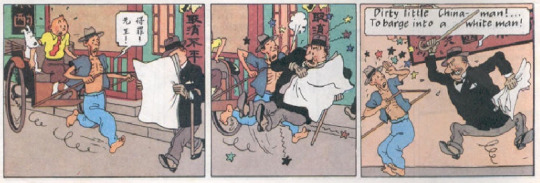
(The next panel is Tintin breaking this awful man’s cane. There’s a lot of instances like this throughout the series, where someone’s being a dick to a POC, and Tintin lets them have it. Yes, it’s robbing the POC of agency in favour of Tintin as mightiest of whities, you could call it racist, but it’s not quite a Klan march, is it?)
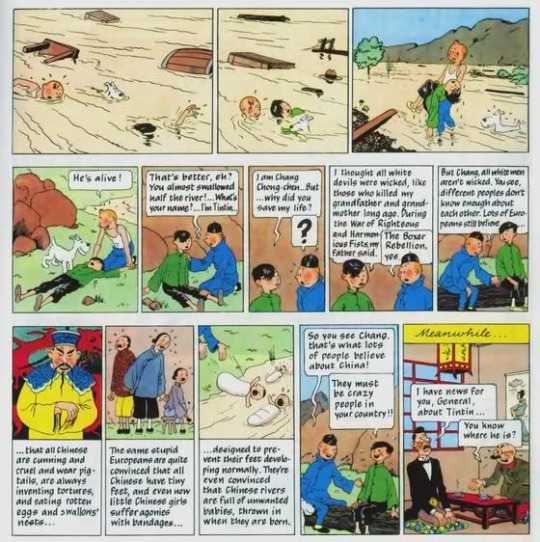
Certainly they’re depicting racism, but is anyone really looking at those and getting the impression that the author endorses Native Americans being thrown off their land? Or that the author agrees with the stereotypes he’s calling people stupid for believing? (The stereotypical Chinaman picture serves as a bit of a brick joke when, later on, Thomson and Thompson attempt to blend in.) Those last two excerpts are from The Blue Lotus, often held up along with Tintin in Tibet as a rebuttal to the charges of racism laid against Herge (largely because of Chang, based on one of Herge’s life-long friends). Ironically, The Blue Lotus was criticised for racism against the Japanese: the villain, Mitsuhirato (that’s him in the last panel) is a pug-nosed, buck-toothed opium trafficker who commits seppuku after the climax, so it’s a fair cop, although The Blue Lotus depicting Imperial Japan as authoritarian warmongers claiming more and more of Manchuria on flimsy pretexts has perhaps been vindicated by history.
Brockway’s column describes Tintin as ‘a racist Indiana Jones...for kids’, and this is basically accurate, although I think it’s debatable whether Tintin is more Indiana Jones or James Bond. (Last Crusade, apparently, began life as Spielberg’s Tintin fan script.) You could easily go with both - the crucial points are the globe-trotting, the intrigue, and Tintin’s own indomitable capability. To paraphrase another Cracked columnist, the weird thing about Tintin is that he was awesome. He looks like a cherub but will happily get mixed up in, and win, a fistfight or gunfight any day. He’s about 19 and already has a nemesis - a Greek nemesis. Despite being half a boy, and despite being a journalist who never writes anything, he’s self-sufficient in every way, and as physically capable as a man twice his size - which can flow back into the mighty whitey stuff in some fairly unfortunate ways:
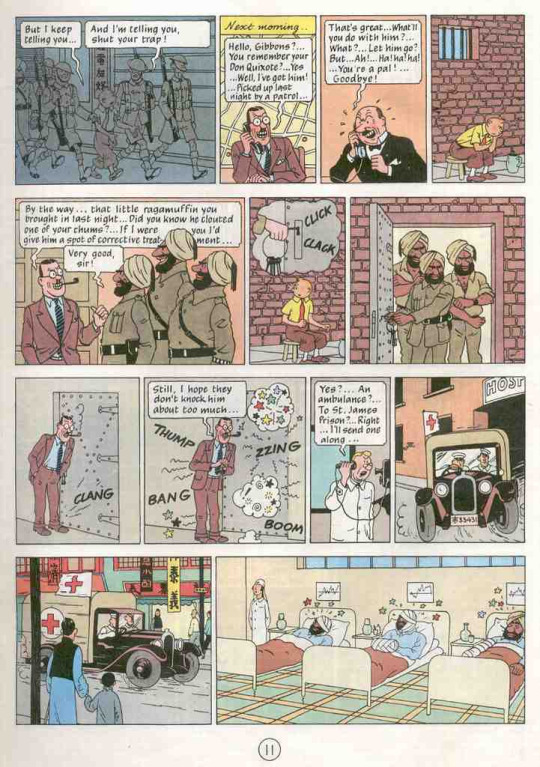
but then again, take the racial dynamic out of that page (or, if you prefer, focus more on the white colonialists bossing about the South Asian guys) and it’s pretty standard protagonisty stuff.
The series is ‘for kids’ in that Tintin is your classic boy hero - given his trusty dog companion, it’s a lot like one of The Famous Five aged a few years and got a real job - and a lot of the humour is generally accessible, slapstick stuff - there’s a bit in Tintin in Tibet where Captain Haddock spends about three pages bumping into people and tripping over. Then, out of nowhere, an international arms dealer will plant opium in Tintin’s luggage to get him banged up by the cops. Seriously, most of the villains are gun-runners, opium smugglers, or both - there’s nothing too graphic, no Trainspotting-style illustrations of the full horror of the global opiate trade, but still, heavy stuff for a comic book. Particularly considering the great costumed comic heroes never even touched the subject of drugs until around the ‘80s, and an endless stream of edutainment telling kids to hey, just say no, man.
One crucial difference between Tintin and Indiana Jones/James Bond is the series’s utter sexlessness. Female figures, on the rare occasion they show up at all, are either damsels in distress, desexualised mother-types, or both. This aspect of the series has drawn its share of Freudian analysis over the years, and, due to Tintin’s best friend and roommate being salty seaman Captain Haddock, came in for a bit of ribbing in the bootleg Tintin in Thailand. If you were to put James Bond into that machine from Red Dwarf that splits things into their good and evil selves, you’d end up with Tintin and Sterling Archer.
Really, Tintin’s closer to a modernist-era Hitchcock protagonist, who gets swept up in events and has sufficient pluck to see them through, and while I forget which way round the inspiration came, The Black Island bears a striking resemblance to Hitch’s The 39 Steps. To stick with The Black Island a moment - being half-Scottish, it was always a family favourite - I’d just like to present the first page in full:

Take note, any film or narrative that wants me to spend fifteen minutes with idiots, because that’s how you kick off an adventure. There’s your wholesome protagonist out for a walk with his dog, and there’s your bad dudes up to bad shit. Tintin spends the night in hospital, then proceeds to walk off the bullet going after the guys - who, it turns out, are some conspicuously German forgers operating in Britain, in 1938. Again, there’s nothing too graphic, but perhaps that’s bending the definition of the word for a work that involves the protagonist stepping in a bear trap, nearly being consigned to a Nazi asylum, getting knocked out during a gunfight with a White Russian when his bullets smash some bottles of chloroform, and then getting caught in a house fire (all this, incidentally, happens in one sequence of five pages or so).
To return to The Blue Lotus, one of Tintin’s allies in that, Mr Wang Chen-yee, more-or-less fits the bill for @thathopeyetlives and @raggedjackscarlet‘s idea of a mirror-universe Rocky Horror Picture Show, in which Bizarro Frank-N-Furter comes to represent the good side of traditionalism, the idea that ‘here is something worth believing in, if you dare to’:
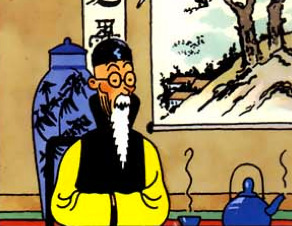
Yeah, he’s a stereotype - you know it, I know it - he’s that specific kind of East Asian man they invented the word ‘venerable’ for, and the fact that at no point in The Blue Lotus does he use kung fu to devastating effect just makes you more certain he’s a master of it. But crucially, he seems like - as with Speedy Gonzales - the kind of stereotype the people it depicts could really get behind.
Mr Wang is the leader of The Sons of the Dragon, a secret society - and a robust, active secret society at that, much closer to the mafia than to the Freemasons (or, if you like, closer to the classic Freemasons than the modern Freemasons). Tintin first meets him after having been kidnapped and smuggled back into China, on his orders - and Mr Wang is hoping that Tintin will help them to fight opium smuggling. How perfect is that for a secret society? There’s your completely justified underdog, there’s something you can believe in, or at least you could before world governments introduced some anti-drugs boilerplate and fucked everything up for everyone.
There was a very mild religious grounding to Tintin - it didn’t come up a lot, but to be fair these were still the days when religion and a moral core were thought of as basically one and the same. It wasn’t lessons in theology like Linus in Peanuts, it was a more general use of universally recognisable icons, a lot closer to how Baikinman was elevated to go-to antagonist symbol in Japan - here’s the villains of Tintin and the Broken Ear being literally dragged off to hell:

Here’s Tintin invoking heaven’s name to try and stop the villain from capping himself (luckily, his gun’s been switched for a joke one):

And here’s Snowy grappling with his alcohol problem via his good and evil selves:
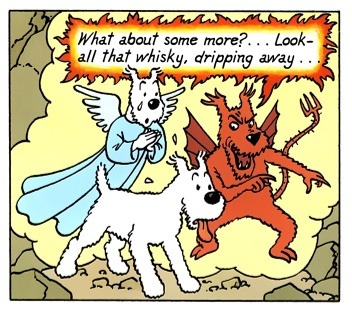
(That’s not a joke. Snowy’s taste for hard liquor was a recurring theme, at one point leading to Tintin spanking him as punishment for getting drunk in the Himalayas and nearly going over a waterfall - both content which I suspect simply wouldn’t fly today in the face of the animal rights lobby, at least not in a children’s book.)
Interestingly, this isn’t limited to Christian theology - here’s Snowy again, this time envisioning Tintin’s wrath by having him wield Zeus-style thunderbolts:
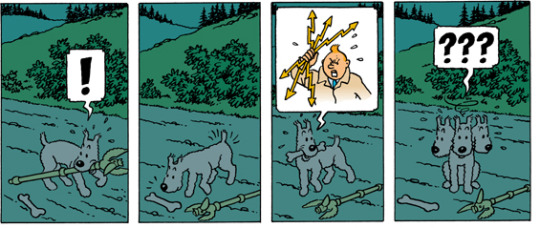
And a Buddhist monk levitating while in a prophetic trance:
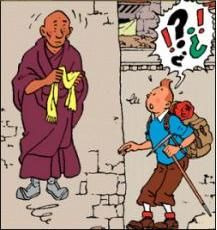
Similarly, bona fide magic makes some semi-regular appearances in the series. In Cigars of the Pharaoh, Tintin is temporarily hypnotised with one glance from a fakir, but the most audacious depiction of this comes in The Seven Crystal Balls/Prisoners of the Sun, in which ball lightning attacks the gang, causing Professor Calculus to levitate, and it turns out the neo-Incas have been using what are essentially voodoo dolls to torment the explorers who looted their temple - this is particularly jarring in Prisoners of the Sun, contrasted as it is with Tintin’s little yay-science moment of getting out of his own execution by exploiting his knowledge of an upcoming solar eclipse.
In a way, all this magic and the various acts of god were an extension of the deus ex machinas that were a staple of the series from the start. Tintin in America is probably the worst offender in this regard, with the most ridiculous moment being a toss-up between the time the meatpackers go on strike and turn off the machinery seconds before gangsters throw him into it, and the time he gets chained to a barbell and thrown in a lake, only to discover the barbell’s inexplicably been switched with the wooden barbell of a crooked strongman.
Come the later adventures, though, the deus ex machinas would take a slightly different form to the literal intervention of god:
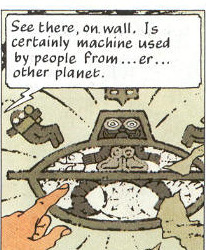
That’s not out of context, that’s not an idle aside - in Flight 714, the second-to-last complete comic, the gang gets out of a tight spot (an erupting volcano-cum-ancient ruin, no less!) when literal fucking aliens turn up to save the day and cart off the baddies. And, unlike most narratives of that ilk, they get out of it with definitive proof of extraterrestrial contact - Professor Calculus brings back a bit of metal composed of an alloy that does not exist on earth, although this is played off as a product of his cloth-eared eccentricity.
Even with the time difference, you’d probably say there’s surely a bit of a leap between the wholesome-but gritty early exploits of Tintin, where he’s running around after forgers and smugglers, and where he’s literally encountering aliens. Fortunately, there was an adventure that bridged that gap very nicely:
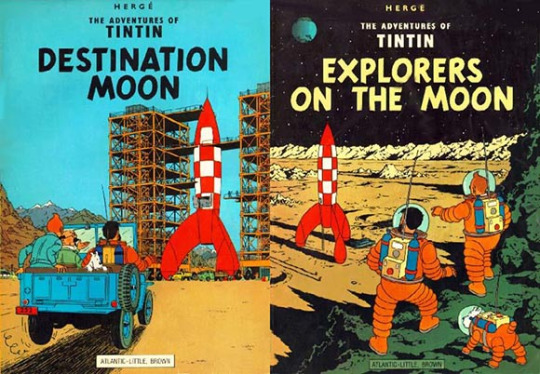
And you may well gather from that adorably kitsch rocket that this went down long before the actual moon landings - but despite this, Herge had done his research, he didn’t have the place turn out to be composed of cheddar like Wallace and Gromit’s A Grand Day Out, he depicted space travel and lunar survival reasonably accurately. A lot of people credit the white expanses of Tintin in Tibet as Herge’s masterpiece, but man, the inky blackness of Explorers is surely its underdog brother:

The final adventure, Tintin and Alph-Art, exists only as concept art and various bootleg versions. It features some genuinely radical departures from the established norm - a black Jamaican artist gets to have a heroic moment of his own, rather than just being acted upon by white people, and Tintin plans a date with an actual human woman. So the series obviously had come a long way from the days of publishing a version of Heart of Darkness where Kurtz is the good guy. And to go back to where we started - it’s not like we had to write off Bugs Bunny because of all the times he blacked up, right?
38 notes
·
View notes
Video
youtube
Star Wars Jedi Knight: Dark Forces II (1997)
Max was a demented, diminutive, and destructive member of the bunny species. Over the course of his career, he worked with several different beings, such as an unidentified sentient dog and New Republic agent Kyle Katarn. His visage could be found in various locations across the galaxy, notably in Fuel City on the world of Sulon. On that same planet, Max stayed at the House of Max, in the capital city of Barons Hed. Later, he teamed up with Katarn to hunt down Derrida, a Ketton spy who had taken refuge at the Kwenn Space Station. Max and Katarn succeeded in apprehending their quarry but nearly destroyed the station while doing so.
Biography Max was a pint-sized bunny, homicidal and demented by nature. He worked frequently with an unidentified sentient member of the dog species and was considerably dangerous in his work, though he asked for only a small fee.
Max's visage could be found in at least two locations: A representation of his head adorned the interior of a Buick spacecraft as well as fueling pipes within Fuel City on the planet Sulon. In 5 ABY, Max was staying at the House of Max in the city of Barons Hed, the capital of Sulon. He was sharing a room with a Human female and had armed himself with a modified Bryar pistol that could fire repeating blasts.
One day, when Max's companion decided to go to a nearby market, a man named Kyle Katarn barged into their home. Katarn, a New Republic agent, was pursuing a personal vendetta against the Dark Jedi Jerec and sought to reach the city's Government House. There, the droid 8t88 was deciphering a map to the Valley of the Jedi, which Katarn's late father had sworn to protect.
Katarn had taken it upon himself to pursue the matter; however, Gran thugs and Grave Tusken mercenaries prowled the streets of Baron's Hed, making Katarn's trip hazardous. Max decided to accompany Katarn on his journey and took his heavily modified pistol to the numerous thugs in a haphazard and frantic manner. Once Katarn reached the Government House, the pair parted ways.
Behind the scenes The character Max belongs to artist Steve Purcell's animated media franchise, Sam & Max, which first found commercial success in 1987 as a full-length comic series. Purcell eventually went to work for LucasArts as an animator and began writing Sam & Max comics for the LucasArts quarterly magazine The Adventurer, including several that parodied Star Wars. In 1993, LucasArts released the first Sam & Max video game, Sam & Max Hit the Road, which Purcell helped design. Max, sometimes accompanied by Sam, has also made Easter egg cameo appearances in several other LucasArts video games, including Indiana Jones and the Last Crusade: The Graphic Adventure, The Secret of Monkey Island, and Day of the Tentacle, among others.
Max also makes cameos in a number of LucasArts Star Wars games, including Star Wars: Dark Forces (1995), in which the outline of Max's head is visible on a map of the Ice Station Beta facility; Star Wars: Shadows of the Empire (1996), which uses Max's likeness to represent a "Challenge Point" icon in the game's Mos Eisley level; Star Wars: Jedi Knight: Dark Forces II (1997); and Star Wars: Rogue Squadron III: Rebel Strike (2003), which includes Max's head in the "cockpit" of the game's un-lockable Buick feature.
Yet 1997's Jedi Knight: Dark Forces II remains Max's most substantial cameo. In the game, Max is featured in two cameos, the lesser appearing in "Level 9: Fuel Station Launch." At the end of the level, the player can see three images of Max's face on a part of Fuel City's docking array. However, the more significant cameo takes place in "Level 5: Baron's Hed – The Fallen City." If the player moves across the lowest step of a staircase in the early stages of the level, a woman in a nearby building will open a door and leave. If moving quickly enough, the player can sneak in through the opened door. If too slow, the player can wait for the woman to return and reopen the door. Within the building, standing on a large chair, is Max, armed with a Bryar pistol. If the player interacts with Max, the bunny will help the player throughout the rest of the level. Should the player fire on Max, the bunny will return fire. Players can also interact with Max once more to activate the "MaxCam," which shows the level from Max's perspective.
The Dark Forces II strategy guide later identified Max by name and provided tips to help players find the "Easter egg." Max's physical appearance in the game hews closely to Purcell's original drawings, and his zealous wielding of a proportionally oversized gun is culled directly from the Sam & Max mythos.
Canonicity Regarding Max's canonicity within the Star Wars Legends continuity, The Dark Forces Saga, a series of game scenarios written by Jason Fry and Abel G. Peña in 2005, identified one of Kyle Katarn's comrades as a "demented, pint-sized lagomorph." The same phrase had previously been used to describe Max within Sam & Max Hit the Road, and Peña later confirmed that the lagomorph in question was indeed Max. Peña purposely referenced Max in connection to the spy Derrida as a homage to the real-world philosopher Jacques Derrida, a Deconstructionist. Peña felt that the message of Deconstructionism as appropriate when referencing a "quasi-canonical Easter egg" like Max because Star Wars continuity, like reality, is uncertain and will "always be undermined."
Source: Wookieepedia
1 note
·
View note